BU7405 Strategic Management Assignment Sample
Introduction
Strategic management can be referred to as the process of setting goals, objectives, and procedures for the purpose of making the company more competitive in nature[1]. Appropriate strategic management can bring forward excellence in the company in terms of financial and non-financial aspects.
It has various advantages such as it provides a framework for decision making, provides a perspective for the organisation, enables a measure for the progression of the company and others. This study aims to analyse the issues of strategic management which H&M has been encountering. Issues of strategic management can create several problems of the internal management of the company which can negatively impact the operations of H&M to a certain extent. Furthermore, these impacts would be analysed which could affect the performance of the company on the basis of its competitiveness.
In the primary section of the study, a brief background of the company would be presented and as the study proceeds the issues and the impacts would be discussed in detail. Furthermore, few recommendations would also be provided which can be incorporated by the company in order to enhance the strategic management and bring flourishment into the company.
Company and industry background
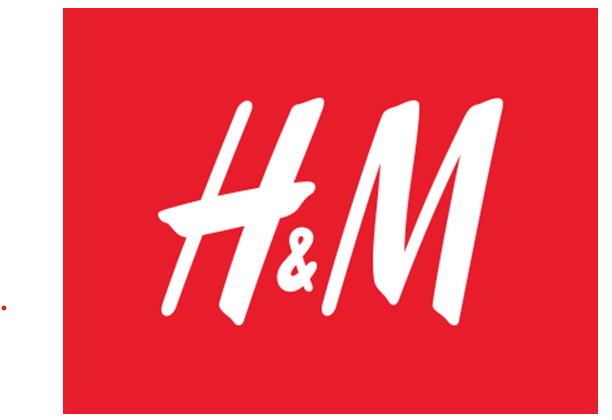
Figure 1: Logo of H&M
(Source: [2])
H&M is also known as Hennes & Mauritz AB which is an international company established in 1947 with its headquarter in Stockholm, Sweden[3]. The core business of this company is mainly to focus on fast fashion for women, men, children, and teenagers. As of 2019, the company has been witnessed to be operating in 5,076 locations globally. In the same year, H&M had generated a revenue of about US$24.8 billion. In addition to that, the number of employees associated with the company are 126,376 as per 2019.
The company also has its subsidiaries namely, Weekday, Monki, COS, Cheap Monday, and others[4]. The company of H&M is the second-largest retailer for clothing in the world behind Inditex. Online shopping facility is also available by the company for 33 countries.
In addition to that, H&M has a passion in terms of fashion and a desire to fulfil the desires and expectations of the consumers which increases the level of consumer satisfaction. Furthermore, it has been observed that the largest market of H&M is in Germany[5]. In the year of 2019, around US$3.5 billion was generated from this country specifically. H&M is known to operate in over 5000 stores globally. In addition to that, as of 2020, H&M was regarded as the seventh most valuable fashion brand in the globe.
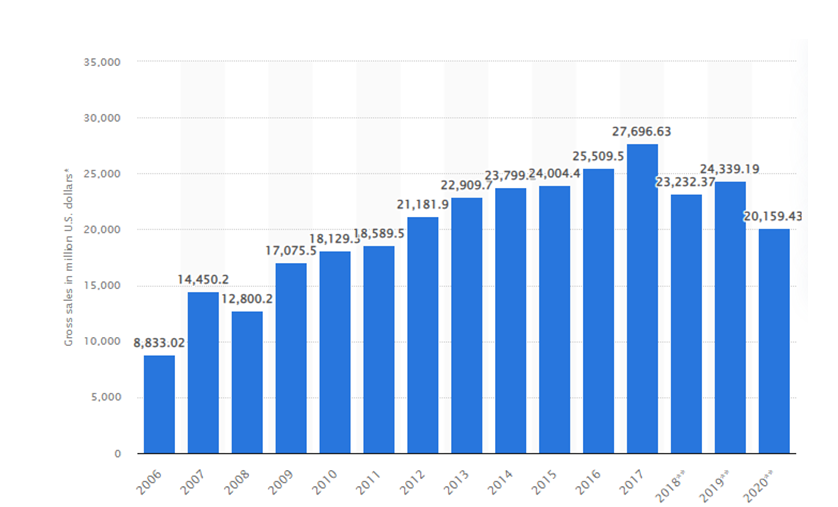
Figure 2: Sales of H&M over the years
(Source:[6])
From the above figure, it can be seen that the sales of the company have been rising from 2008 to 2020 with a gross sales of US$ 12,800 million to US$ 20,159.43 million respectively[7].
Outline of two strategic business issues
Business strategy plays a significant role in leading the organisation towards success. It helps the corporation to create a vision along with guiding them towards the targeted goals.
Therefore, issues in strategic business can severely hamper the organisational future by creating a complex situation across the workplace. In this context, the following study will reflect strategic business issues of the renowned corporation H&M through which the entire report will be structured effectively.
Lack of search engine optimization strategy and online strategy
People are far more likely to use one of the five top options presented by a web browser while looking for a product or service available on the internet. SEO helps the companies rank top of the search results and achieve increased website presence, increasing the likelihood that prospective buyers will access the website and engage.
In this relation, the SEO strategy of H&M is identified to be lagging somewhere. After the poor performance of the organisation during 2017, the brand has consecutively closed approximately 140 stores[8]. In this relation, the following figure will reflect the insight of the organisation about their new stores and closed stores comprehensively.
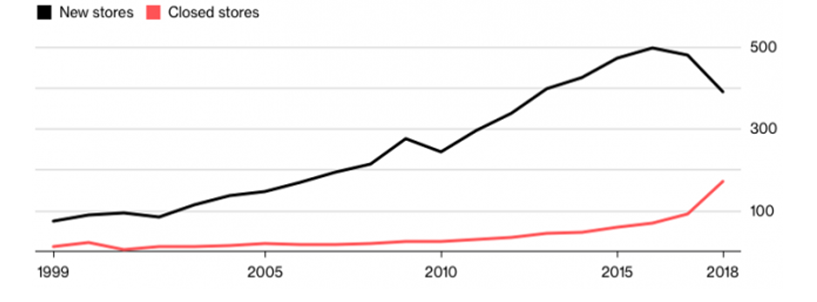
Figure 3: H&M stores insights
(Source:[9])
The reason behind the closure of stores and degrading performance in the marketplace can be acknowledged to be the reason due to the lack of strategy for their online presence. The traditional market is still there in the marketplace; however, the growth of online marketing is unstoppable since the outbreak of covid-19 pandemic.
As per the recent published statistics, revenues of global e-commerce increased by 4% to reach $26.7 trillion during the year 2019[10]. http://BU7405 Strategic Management Assignment SampleHandling both online and physical stores has become one of the most key factors for the organisation as there are changing consumer demands nowadays.
Given the strength of a brand, it is understandable that H&M’s strategy has focused mostly on its physical locations. Nonetheless, it is probable that H&M missed out on the effectiveness of online revenue from sales of this focus.
In 2010, H&M became the first retailer to offer digitally, more than a decade after ASOS. It indicates that the corporation was either late to understand the possibilities of e-commerce or felt that such an existing business model would be inadequate to gain control over potential markets.
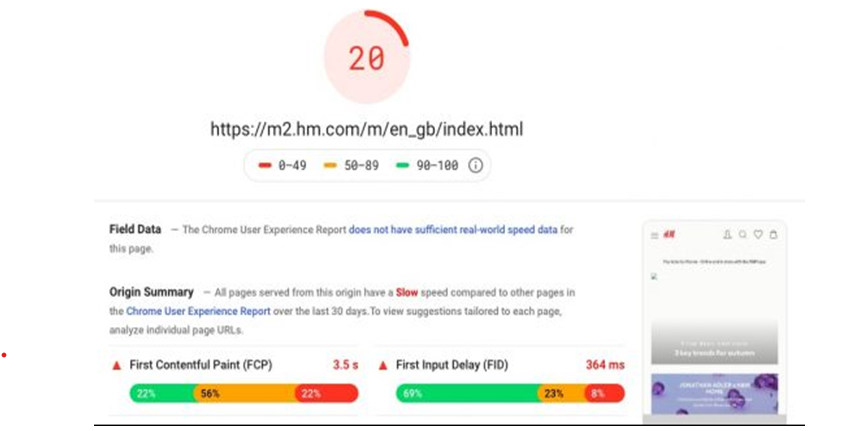
Figure 4: Webpage store of H&M at UK
(Source: [11])
As mentioned in the above figure, the UK website of H&M has scored only 20%, which is the area that needs to be addressed by the organisation really soon to continue their influence over the marketplace.
The webpages were also badly built, with numerous challenges and limitations that made it more difficult to create revenue from them. Although it has subsequently developed, the H&M website was highly flawed in its formative days [12].http://BU7405 Strategic Management Assignment Sample The lack of online strategies in the organisation has directly impacted over the charges they take as delivery fees.
The corporation has thought that covering up the cost with the help of taking delivery charges will significantly help, in this case scenarios, H&M have charged £3.99 standard purchases[13]. This tactic can significantly affect shoppers who are buying stuff online as the rival organisations are offering free delivery and returns.
Poor inventory and supply chain strategy
Inventory management is important to a business’s success since it avoids overstocks and imprecise records. Supply chains, on the other hand, are mechanisms that connect businesses to respective vendors, permitting companies to manufacture and distribute products and services[14]. http://BU7405 Strategic Management Assignment SampleH&M appears to have a vertically efficient supply chain, exporting roughly 80% of production to Eastern offshore locations and procuring the rest 20% from European suppliers. Additionally, H&M do not own manufacturing operations and depend entirely only on those supplier relationship management[15]. They were successful in gaining a significant competitive edge by utilising overseas outsourcing, which benefited from cheaper labour and more adaptive regulatory production requirements. To strengthen its commerce inventory management, distribution network, and sales, the company intends to spend in intelligence and analytics. The company would also engage far more in the hardware and system to expand its utilisation of cloud computing and 3D scanning[16].
On the flipside, it hampered business by extending production time to 6-8 months thus limiting supply versatility. The organisation has started to overhaul their supply chain in order to meet with the competitor Zara.
Cost reductions and exchange rate implications enabled the company’s quarterly earnings before interest and taxes earnings to drop to 3.21 billion from 3.33 billion yearly previously, beating an average prediction of 2.87 billion[17].
Despite achieving a historical high record 2 years ago, H&M equities reportedly lost the majority of market share. H&M’s supply chain strategy to resemble Zara Inditex’s may be a complete challenge, although it would be contradictory with H&M’s significantly lower price because manufacturing is more expensive than that in Asia.
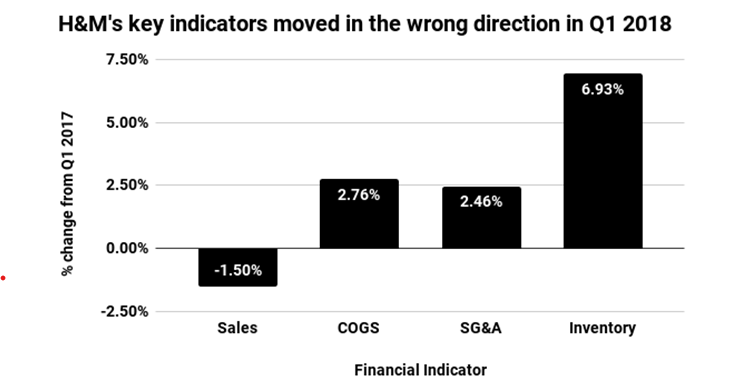
Figure 5: H&M departments which backfires
(Source: [18])
As the above mentioned figure suggests that nearly all of the departments were moved in the wrong direction. However, this cannot be figured out so easily, something like a stronger production cycle or good weather that H&M’s finances will recover.
There is more at issue is the fast-fashion corporate structure, which is struggling from the consequences of its own sharp company profits. In this context, H&M’ CEO has stated “The fashion industry is changing fast. At the heart of the transformation is digitalisation and it is driving the need to transform and re-think faster and faster”[19].
Supply chains are the most significant part of an organisation who have to deal with customer satisfaction and thrive in the marketplace. H&M need to invest in their supply chain that will effectively allow them to overcome all of the potential challenges. Furthermore, the next section will briefly analyse and justify the issues subjected above along with strategic implication by integrating theories.
Justifications for the issues to have strategic implications
The mentioned strategic business issues from the perspective of H&M reflects profound interrelation with potential threats that can create an obstacle in the way of achieving adequate future growth opportunities.
The present changing dynamic business environment has been experiencing prolific development and emphasis upon digitisation as an integral part of satisfying consumer demands and thereby, improving seamless customer experience[20].
The company has been notified to struggle regarding the adoption of online retail trends. The reason for considering this issue with strategic implications from the organisational perspective highlights ineffective decision-making from the organisational leadership. The company decided to consider change management in their strategic interventions with the consideration of both online and offline presence. However, this initiative of the organisation can be profoundly compared with the consequences of disruptive innovation theory.
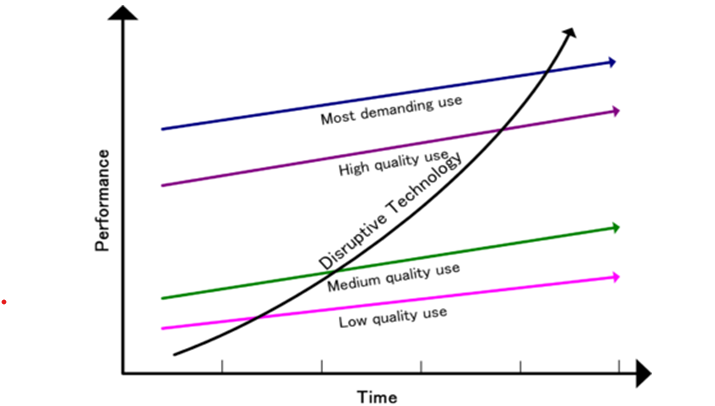
Figure 6: Disruptive innovation theory
(Source: [21])
The theoretical belief has highlighted an innovative process through which a small organisation with comparatively few resources in the market is allowed to challenge an incumbent (established business) by gradually moving upwards aftr entering at the bottom[22].
Different steps can be noticed behind this process, which includes the development of existing services and offerings for appealing to the potential target customers.
Moreover, the small companies can eventually focus on the ignored market parts for obtaining adequate consumer attraction. Innovative solutions can eventually be offered by the small companies in order to appeal to the mainstream consumers of the incumbent[23].
Similar consequences can be reflected from the perspective of H&M, where the organisation initiated to conceptualise disruptive innovation with rapid growth of online strategy.
From this standpoint, the consideration of disruptive innovation can be certified from their perspective with the clause of developing existing services and offerings in order to appeal to the most profitable and demanding consumer segment. It eventually enlightened the organisational desire of efficiently entering and dominating the UK retail market with a profound omnichannel business strategy.
For example, the UK online apparel market can be considered which experienced 24% of their entire clothing sales in 2018 through online channels[24]. This was also equivalent to £ 11.6 billion sales through online out of £ 48.1 billion in retail sales[25]. These statistics eventually reflect the strategic intervention of potential UK retailers to make their products easily disclosed with a simple click by profoundly relying on digitisation.
This prospect also highlights the organisational possibilities of efficiently surviving the comparative fashion landscape by efficiently mitigating the latest consumer trends. However, H&M had to fall behind in this online strategy segment where the company had also blamed online retail for their reduced footfall across store-based businesses in 2017 as noticed in the statement provided in the organisational 2017 annual report[26].
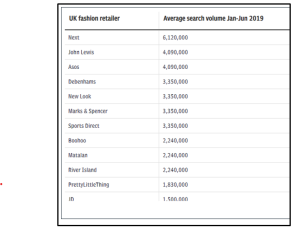
Figure 7: Online strategic growth of renowned UK fashion retailers
(Source:[27])
The aforementioned figure has been demonstrating the gradual growth of online fashion services from the perspective of renowned UK retailers like Next PLC, John Lewis, Marks and Spencer, River Island, Asos and others[28].
Almost similar example of poor online strategy can also be notified from the perspective of Marks and Spencer which experienced website problems that eventually provided a negative influence upon the organisational business and sales growth.
The overall analysis of the organisational online strategy with other respective examples and industrial evidence highlights distinctive strategic intervention undertaken by potential businesses for improvement of profitability and consumer engagement through online channels. From this standpoint, this issue can be justified to have profound interlink with strategic implications of H&M.
The organisation has also experienced distinctive issues with their supply chain management attributes as mentioned above. The consequences of slow and bulky supply chain management created potential threat for the organisation in terms of efficiently mitigating consumer demands and requirements in a timely manner.
For evidence, it can be pointed out that the supply chain lead times within H&M was recognised to be double as compared with Inditex[29]. This evidence highlights inadequate supply chain strategy undertaken by the organisation that can completely ruin competitive advantage on behalf of H&M. The company eventually experienced declining attention of potential investors who initiated to sell the organisational shares in the market.
Due to this reason, the overall shares of H&M declined by 5% in this respective period[30]. However, the organisational chief executive also agreed regarding the maintenance of similar supply chain management strategy despite experience in changing consumer behaviour and operational attributes of the retail sector.
Inadequate attention of the organisation and management towards change adoption in the supply chain in operations highlighted the strategic issues for the organisation in terms of experiencing distinctive brand recognition among potential investors. It also created a point of uncertainty due to which the investors and creditors initiated to release the organisational shares in the market.
H&M eventually lost one third of their market share value in this regard. The consequences of shortcomings in design and supply planning can also be noticed from the organisational perspective that has eventually provided a negative implication upon their financial standings. In 2017, H&M experienced a 3.21 billion crowns decline in their quarterly pre-tax profit[31].
The overall evidence highlight negative influence of a slow and bulky supply chain management maintained by the company upon their market share achievement along with brand recognition in the market. From this standpoint, this attribute can be recognised as a significant strategic issue providing both direct and indirect influence upon the organisational future growth opportunities.
The consequences of the network perspective theory can be considered in this case. The theoretical understanding reflects to focus on the relationship and explanations of entire available networks in order to facilitate interrelation between all levels within an organisational supply chain management[32].
In this case, profound focus of this theory can be signified upon the maintenance of improved relationship and engagement with suppliers, purchasers and others.
Based on the issues and challenges faced by the company within its supply chain management and online presence, achieving disruptive innovation within the company can help in minimising these existing strategic risks and issues.
Based on the disruptive innovation theory the organisation can come up with innovative ways to manage their supply chain network which would allow H&M to make their supply chain more streamlined[33]. However, this innovation needs to be new and unfamiliar in the Industry which has not yet been utilised by the competitors of the company.
Apart from that, innovation can also be achieved in terms of increasing the company’s presence on the various online platforms in which it operates. The organisation can learn from examples and disruptive innovations that its competitors such as Zara, Burberry, Nike and others have adopted to minimise strategic risks and issues[34].
These organisations have achieved a competitive position in the market by introducing innovative ways of managing their risks. Hazara has adopted a quite diverse social media and digital marketing strategy to increase its presence in the market whereas Nike has adopted a strategy linked with sustainability to create awareness among consumers regarding responsible consumption.
Impact on the competitive performance
The supply chain of the organisation serves plays a significant role in determining the company’s competitive position in the market. Therefore not being able to utilise the supply chain of the organisation to its full potential can have a negative impact on the company’s competitive performance.
It has been seen that the organisation has been suffering due to its bulky and ineffective global supply chain due to which the organisation is not able to meet up to the demands present in the market. As a result, the competitors of the company and moving ahead of H&M which is a major matter of concern for the company in the present context[35].http://BU7405 Strategic Management Assignment Sample
The lack of flexibility in the organisation’s supply chain can cause competitive issue performance considering the fact that the competitors of the company are moving ahead with better supply chain performance.
It would be essential for the organisation to minimise these existing risks and gaps present within its supplies and to ensure that the target customers are receiving the products and services offered by the company. Another aspect due to which the drop in the company’s supply chain can affect the competitive performance is due to the fact that it increases the operational costs[36].
As a result of increasing operational costs, the organisation would not be able to provide its product and services at favourable prices which can have a major impact on the competitiveness in terms of pricing strategy. Unable to maintain the profit margin of another company can lead to declining revenue and this would mean that the organisation would not have the desired rate of cash flow.
Hence if improvement in the organisation’s supply chain and not done then the company would face issues in terms of maintaining the consumer base, position in the market, as well as declining revenue[37].
Another issue that has been identified regarding the company’s strategic issues is the lack of visibility over online platforms due to which search engine optimization capabilities of the company have been found to be quite underdeveloped.
Due to the lack of SEO capabilities of the organisation the target customers of the company are not able to find other companies or its products when they search online.
Since a major part of the company sales is based on its eCommerce platform it is essential for the organisation to maintain visibility over the internet else The E-Commerce operations of the company would deliberately fail.
Apart from that, the competitors of the organisation have better visibility and brand recognition around the globe, which is another major negative impact on the company’s competitive position. The lack of online visibility can detrimentally hamper the organisation’s online sales which would only be limited in the company’s sales through their retail stores located in different markets.
However, generating enough revenue to support omnichannel operations cannot be achieved only by the support of retail stores. It has been seen that organisations that operate omnichannel operations pay equal importance to both their online sales as well as sales through retail stores[38].
Moreover, if the organisation is not able to revive expression on the online platforms specifically on social media platforms then the companies brand image and overall brand equity would subsequently decline.
Maintaining brand equity and performance of the organisation greatly depends upon the ability of a company to reach out to its target customers and in this regard, H&M has been falling short quite significantly[39]. Furthermore, the value of the company to its potential customers also depends upon the overall brand value of the organisation and in this regard maintaining a competitive position in the market is greatly dependent upon the organisation’s ability to remain visible to its target customers.
Recommendation
Publishing of authoritative and relevant content
Search engine optimisation (SEO) can be regarded as extensively crucial for any organisation in order to come to the vision of the target consumers. Therefore, authoritative content with maintaining its quality can play as a major driver in terms of search engine ranking of the company[40].
In this regard, there can be no great substitute to great content, thus, quality content can be created by H&M in order to increase the traffic of the site. In addition to that, fine tuning of the web writing skills can be extensively crucial for improving the site’s relevance and authority.
Regular updation of the content
In today’s world, content can be said to be the most important for drawing the attention of the people. Therefore, aside from creating quality content by the company of H&M, regular updates of the contents are extremely crucial.
It can be further said that regular updating of content gets seen by the users as relevant and authentic. Furthermore, the data which are back-dated are often seen as out-dated and not much relevant. However, frequently updating of content can eliminate that perception and can make the site more attractive, drawing the attention of the people.
Automation of the warehouses
In recent times, several companies are automating their warehouses through the utilisation of the robots in order to speed up the working processes of the company[41].
By incorporating automation, the error which can be caused by humans can be subsequently eliminated to a great extent which also helps in lowering the costs from wastes. In addition to that, robots make working in the company way faster than the human.
Therefore, H&M needs to automate their warehouses for mitigating issues in regards to slow management of the supply chain. With the use of robots, the risks of accidents caused to the employees can also be lessened to a great extent.
Partnering with autonomous vehicles for logistics
In various cases, it can be seen that companies delay their supplies due to insufficiency of the drivers due to the driver shortage. These actions can impact the consumers’ perception towards the company[42].
Every customer wants to get their ordered product within the pre-mentioned time otherwise which can increase the chances of losing that potential consumer. In addition to that, stores can witness a shortage of stock due to this issue of driver shortage which can additionally create issues with the operations of the stores. Therefore, H&M can partner with autonomous vehicles that can help the company with its logistics during the time of need.
Increase the number of distribution centres
The distribution centres of the companies need to be analysed in order to speed up the flow of supplies. Therefore, H&M can increase the number of distribution centres from where the distance of the logistics can be minimised.
This step would help in increasing the flow of supply and can also provide such options of same day or next day delivery to the consumers which would further help in keeping the consumers loyal towards the company.
Conclusion
Concluding from the findings in the above study it has been seen that strategic issues of an organisation can significantly impact a company’s competitive position in the market. In this regard, the above study explores the case of H&M and identifies two of the most persistent issues of other companies link with its supply chain performance and online presence.
The study has highlighted how the presence of these issues can detrimentally impact the company’s competitive position while also reflecting why these issues have strategic implications for the company’s operations. The study has also helped to understand the major drawbacks of the company’s supply chain.
Adding to that, the study also reflects the impact of these issues on the company’s competitive performance along with a set of recommendations that aim to revive the company’s position by suggesting strategies and ways which can help in strengthening the organisation supply chain management and online presence. The study has also helped in identifying how such competitive issues faced by companies like H&M turn out to be a major matter of concern especially in a highly competitive market where other organisations operate in a highly aggressive manner.
References
Abdirad, M., & Krishnan, K. (2021). Industry 4.0 in logistics and supply chain management: a systematic literature review. Engineering Management Journal, 33(3), 187-201. <https://www.tandfonline.com/doi/abs/10.1080/10429247.2020.1783935>
Alcácer, V., & Cruz-Machado, V. (2019). Scanning the industry 4.0: A literature review on technologies for manufacturing systems. Engineering science and technology, an international journal, 22(3), 899-919. <https://www.sciencedirect.com/science/article/pii/S2215098618317750>
Charlton, G., (2021). What’s the problem with H&M’s online strategy?. Retrieved from: <https://dotknowledge.uk/articles/view-article/what-s-the-problem-with-h-m-s-online-strategy->
Childs, M. & Jin, B., (2018). Nike: An Innovation Journey. In Product Innovation in the Global Fashion Industry (pp. 79-111). Palgrave Pivot, New York. <https://ndl.ethernet.edu.et/bitstream/123456789/73541/1/214.pdf#page=93>
Christensen, C. M., McDonald, R., Altman, E. J., & Palmer, J. E. (2018). Disruptive innovation: An intellectual history and directions for future research. Journal of Management Studies, 55(7), 1043-1078. <https://onlinelibrary.wiley.com/doi/pdf/10.1111/joms.12349>
Churchill, F., (2018). H&M invests in supply chain after poor results. Retrieved from: <https://www.cips.org/supply-management/news/2018/february/hm-invest-in-technology-after-disappointing-results/>
Croom, S., Vidal, N., Spetic, W., Marshall, D. & McCarthy, L., (2018). Impact of social sustainability orientation and supply chain practices on operational performance. International Journal of Operations & Production Management. <https://pure.qub.ac.uk/files/151774220/Impact_of_Social_Sustainability_Orientation_and_Supply_Chain_Practices_on_Operational_Performance.pdf>
Daly, H., (2019). Fashion retail: market trends, digital strategies and top searches. Retrieved from: <https://www.telegraph.co.uk/business/search-marketing/latest-digital-trends-fashion-online-retail/>
Das, C. & Jharkharia, S., (2018). Low carbon supply chain: A state-of-the-art literature review. Journal of Manufacturing Technology Management. <https://www.emerald.com/insight/content/doi/10.1108/JMTM-09-2017-0188/full/html>
Ellram, L.M. & Murfield, M.L.U., (2019). Supply chain management in industrial marketing–Relationships matter. Industrial Marketing Management, 79, pp.36-45. <https://e-tarjome.com/storage/panel/fileuploads/2019-08-24/1566635278_E12804-e-tarjome.pdf>
Fuertes, G., Alfaro, M., Vargas, M., Gutierrez, S., Ternero, R., & Sabattin, J. (2020). Conceptual framework for the strategic management: a literature review—descriptive. Journal of Engineering, 2020. <https://www.hindawi.com/journals/JE/2020/6253013/>
Giomelakis, D., Karypidou, C., & Veglis, A. (2019). SEO inside Newsrooms: Reports from the Field. Future internet, 11(12), 261. <https://www.mdpi.com/595336>
H&M, (2022). About H&M Group. [Online]. Retrieved from <https://hmgroup.com/about-us/>
Inoue, H., & Todo, Y. (2020). The propagation of economic impacts through supply chains: The case of a mega-city lockdown to prevent the spread of COVID-19. PloS one, 15(9), e0239251. <https://journals.plos.org/plosone/article?id=10.1371/journal.pone.0239251>
Irish Times, 2017. H&M too slow for ‘fast fashion’ world Retrieved from: <https://www.irishtimes.com/business/retail-and-services/h-m-too-slow-for-fast-fashion-world-1.3030729>
Kilimci, Z.H., Akyuz, A.O., Uysal, M., Akyokus, S., Uysal, M.O., Atak Bulbul, B. & Ekmis, M.A., (2019). An improved demand forecasting model using deep learning approach and proposed decision integration strategy for supply chain. Complexity, 2019. <https://www.hindawi.com/journals/complexity/2019/9067367/>
Kumar HM, S. (2018). Islam and the Question of Confessional Religious Identity: The Islamic State, Apostasy, and the Making of a Theology of Violence. Contemporary Review of the Middle East, 5(4), 327-348. <https://journals.sagepub.com/doi/abs/10.1177/2347798918806415>
Li, Y., & Zobel, C. W. (2020). Exploring supply chain network resilience in the presence of the ripple effect. International Journal of Production Economics, 228, 107693. <https://www.sciencedirect.com/science/article/pii/S0925527320300840>
Lopez, E., (2018). H&M’s turnaround runs through its supply chain. Retrieved from: <https://www.supplychaindive.com/news/HM-turnaround-runs-through-supply-chain/520495/>
Minh, N. T., & Ngan, H. N. (2021, September). Digital fashion-An optimal solution for fashion industry during Covid-19 pandemic. In AIP Conference Proceedings (Vol. 2406, No. 1, p. 020039). AIP Publishing LLC. <https://aip.scitation.org/doi/abs/10.1063/5.0066478>
Pfister, P., & Lehmann, C. (2021). Returns on digitisation in SMEs—a systematic literature review. Journal of Small Business & Entrepreneurship, 1-25. <https://www.tandfonline.com/doi/abs/10.1080/08276331.2021.1980680>
Reinhardt, R., & Gurtner, S. (2018). The overlooked role of embeddedness in disruptive innovation theory. Technological Forecasting and Social Change, 132, 268-283. <https://www.sciencedirect.com/science/article/pii/S0040162517301828>
Sarkar, M., & Chung, B. D. (2020). Flexible work-in-process production system in supply chain management under quality improvement. International Journal of Production Research, 58(13), 3821-3838. <https://www.tandfonline.com/doi/abs/10.1080/00207543.2019.1634851>
Si, S. & Chen, H., (2020). A literature review of disruptive innovation: What it is, how it works and where it goes. Journal of Engineering and Technology Management, 56, p.101568. <https://onlinelibrary.wiley.com/doi/pdf/10.1111/joms.12349>
Si, S., & Chen, H. (2020). A literature review of disruptive innovation: What it is, how it works and where it goes. Journal of Engineering and Technology Management, 56, 101568. <https://www.sciencedirect.com/science/article/pii/S0923474820300163>
Statista, (2021). Sales of the H&M Group worldwide 2007-2020. [Online]. Retrieved from <https://www.statista.com/statistics/252190/gross-sales-of-the-h-und-m-group-worldwide/>
The Irish Times, (2017). H&M too slow for ‘fast fashion’ world. Retrieved from: <https://www.irishtimes.com/business/retail-and-services/h-m-too-slow-for-fast-fashion-world-1.3030729>
UNCTAD, (2021). Global e-commerce jumps to $26.7 trillion, COVID-19 boosts online sales. Retrieved from: <https://unctad.org/news/global-e-commerce-jumps-267-trillion-covid-19-boosts-online-sales#:~:text=Meanwhile%2C%20global%20e-commerce%20sales,product%20(GDP)%20that%20year.>
Yawar, S.A. & Seuring, S., 2018. The role of supplier development in managing social and societal issues in supply chains. Journal of cleaner production, 182, pp.227-237. <https://www.sciencedirect.com/science/article/pii/S0959652618338101>
[1] Fuertes, G., Alfaro, M., Vargas, M., Gutierrez, S., Ternero, R., & Sabattin, J. (2020). Conceptual framework for the strategic management: a literature review—descriptive. Journal of Engineering, 2020. <https://www.hindawi.com/journals/JE/2020/6253013/>
[2] H&M, (2022). About H&M Group. Retrieved <https://hmgroup.com/about-us/>
[3] H&M, (2022). About H&M Group. Retrieved from <https://hmgroup.com/about-us/>
[4] H&M, (2022). About H&M Group. Retrieved <https://hmgroup.com/about-us/>
[5] Statista, (2021). Sales of the H&M Group worldwide 2007-2020. Retrieved on 15 January from <https://www.statista.com/statistics/252190/gross-sales-of-the-h-und-m-group-worldwide/>
[6] Statista, (2021). Sales of the H&M Group worldwide 2007-2020. Retrieved on 15 January from <https://www.statista.com/statistics/252190/gross-sales-of-the-h-und-m-group-worldwide/>
[7] Statista, (2021). Sales of the H&M Group worldwide 2007-2020. Retrieved on 15 January from <https://www.statista.com/statistics/252190/gross-sales-of-the-h-und-m-group-worldwide/>
[8] Charlton, G., (2021). What’s the problem with H&M’s online strategy?. Retrieved from: <https://dotknowledge.uk/articles/view-article/what-s-the-problem-with-h-m-s-online-strategy->
[9] Charlton, G., (2021). What’s the problem with H&M’s online strategy?. Retrieved from: <https://dotknowledge.uk/articles/view-article/what-s-the-problem-with-h-m-s-online-strategy->
[10] UNCTAD, (2021). Global e-commerce jumps to $26.7 trillion, COVID-19 boosts online sales. Retrieved from: <https://unctad.org/news/global-e-commerce-jumps-267-trillion-covid-19-boosts-online-sales#:~:text=Meanwhile%2C%20global%20e-commerce%20sales,product%20(GDP)%20that%20year.>
[11] Charlton, G., (2021). What’s the problem with H&M’s online strategy?. Retrieved from: <https://dotknowledge.uk/articles/view-article/what-s-the-problem-with-h-m-s-online-strategy->
[12] Kumar HM, S. (2018). Islam and the Question of Confessional Religious Identity: The Islamic State, Apostasy, and the Making of a Theology of Violence. Contemporary Review of the Middle East, 5(4), 327-348. <https://journals.sagepub.com/doi/abs/10.1177/2347798918806415>
[13]Charlton, G., (2021). What’s the problem with H&M’s online strategy? Retrieved from: <https://dotknowledge.uk/articles/view-article/what-s-the-problem-with-h-m-s-online-strategy->
[14] Inoue, H., & Todo, Y. (2020). The propagation of economic impacts through supply chains: The case of a mega-city lockdown to prevent the spread of COVID-19. PloS one, 15(9), e0239251. <https://journals.plos.org/plosone/article?id=10.1371/journal.pone.0239251>
[15] Lopez, E., (2018). H&M’s turnaround runs through its supply chain. Retrieved from: <https://www.supplychaindive.com/news/HM-turnaround-runs-through-supply-chain/520495/>
[16] Alcácer, V., & Cruz-Machado, V. (2019). Scanning the industry 4.0: A literature review on technologies for manufacturing systems. Engineering science and technology, an international journal, 22(3), 899-919. <https://www.sciencedirect.com/science/article/pii/S2215098618317750>
[17] Lopez, E., (2018). H&M’s turnaround runs through its supply chain. Retrieved from: <https://www.supplychaindive.com/news/HM-turnaround-runs-through-supply-chain/520495/>
[18] The Irish Times, (2017). H&M too slow for ‘fast fashion’ world. Retrieved from: <https://www.irishtimes.com/business/retail-and-services/h-m-too-slow-for-fast-fashion-world-1.3030729>
[19] Churchill, F., (2018). H&M invests in supply chain after poor results. Retrieved from: <https://www.cips.org/supply-management/news/2018/february/hm-invest-in-technology-after-disappointing-results/>
[20] Pfister, P., & Lehmann, C. (2021). Returns on digitisation in SMEs—a systematic literature review. Journal of Small Business & Entrepreneurship, 1-25. <https://www.tandfonline.com/doi/abs/10.1080/08276331.2021.1980680>
[21] Christensen, C. M., McDonald, R., Altman, E. J., & Palmer, J. E. (2018). Disruptive innovation: An intellectual history and directions for future research. Journal of Management Studies, 55(7), 1043-1078. <https://onlinelibrary.wiley.com/doi/pdf/10.1111/joms.12349>
[22] Si, S., & Chen, H. (2020). A literature review of disruptive innovation: What it is, how it works and where it goes. Journal of Engineering and Technology Management, 56, 101568. <https://www.sciencedirect.com/science/article/pii/S0923474820300163>
[23] Reinhardt, R., & Gurtner, S. (2018). The overlooked role of embeddedness in disruptive innovation theory. Technological Forecasting and Social Change, 132, 268-283. <https://www.sciencedirect.com/science/article/pii/S0040162517301828>
[24] Daly, H., (2019). Fashion retail: market trends, digital strategies and top searches. Retrieved from: <https://www.telegraph.co.uk/business/search-marketing/latest-digital-trends-fashion-online-retail/>
[25] Daly, H., (2019). Fashion retail: market trends, digital strategies and top searches. Retrieved from: <https://www.telegraph.co.uk/business/search-marketing/latest-digital-trends-fashion-online-retail/>
[26] Charlton, G., (2021). What’s the problem with H&M’s online strategy?. Retrieved from: <https://dotknowledge.uk/articles/view-article/what-s-the-problem-with-h-m-s-online-strategy->
[27] Daly, H., (2019). Fashion retail: market trends, digital strategies and top searches. Retrieved from: <https://www.telegraph.co.uk/business/search-marketing/latest-digital-trends-fashion-online-retail/>
[28] Daly, H., (2019). Fashion retail: market trends, digital strategies and top searches. Retrieved from: <https://www.telegraph.co.uk/business/search-marketing/latest-digital-trends-fashion-online-retail/>
[29] Irish Times, 2017. H&M too slow for ‘fast fashion’ world Retrieved from: <https://www.irishtimes.com/business/retail-and-services/h-m-too-slow-for-fast-fashion-world-1.3030729>
[30] Irish Times, 2017. H&M too slow for ‘fast fashion’ world Retrieved from: <https://www.irishtimes.com/business/retail-and-services/h-m-too-slow-for-fast-fashion-world-1.3030729>
[31] Irish Times, 2017. H&M too slow for ‘fast fashion’ world Retrieved from: <https://www.irishtimes.com/business/retail-and-services/h-m-too-slow-for-fast-fashion-world-1.3030729>
[32] Li, Y., & Zobel, C. W. (2020). Exploring supply chain network resilience in the presence of the ripple effect. International Journal of Production Economics, 228, 107693. <https://www.sciencedirect.com/science/article/pii/S0925527320300840>
[33] Si, S. & Chen, H., (2020). A literature review of disruptive innovation: What it is, how it works and where it goes. Journal of Engineering and Technology Management, 56, p.101568. <https://onlinelibrary.wiley.com/doi/pdf/10.1111/joms.12349>
[34] Childs, M. & Jin, B., (2018). Nike: An Innovation Journey. In Product Innovation in the Global Fashion Industry (pp. 79-111). Palgrave Pivot, New York. <https://ndl.ethernet.edu.et/bitstream/123456789/73541/1/214.pdf#page=93>
[35] Yawar, S.A. & Seuring, S., (2018). The role of supplier development in managing social and societal issues in supply chains. Journal of cleaner production, 182, pp.227-237. <https://www.sciencedirect.com/science/article/pii/S0959652618338101>
[36]Kilimci, Z.H., Akyuz, A.O., Uysal, M., Akyokus, S., Uysal, M.O., Atak Bulbul, B. & Ekmis, M.A., (2019). An improved demand forecasting model using deep learning approach and proposed decision integration strategy for supply chain. Complexity, 2019. <https://www.hindawi.com/journals/complexity/2019/9067367/>
[37]Das, C. & Jharkharia, S., (2018). Low carbon supply chain: A state-of-the-art literature review. Journal of Manufacturing Technology Management. <https://www.emerald.com/insight/content/doi/10.1108/JMTM-09-2017-0188/full/html>
[38]Croom, S., Vidal, N., Spetic, W., Marshall, D. & McCarthy, L., (2018). Impact of social sustainability orientation and supply chain practices on operational performance. International Journal of Operations & Production Management. <https://pure.qub.ac.uk/files/151774220/Impact_of_Social_Sustainability_Orientation_and_Supply_Chain_Practices_on_Operational_Performance.pdf>
[39]Ellram, L.M. & Murfield, M.L.U., (2019). Supply chain management in industrial marketing–Relationships matter. Industrial Marketing Management, 79, pp.36-45. <https://e-tarjome.com/storage/panel/fileuploads/2019-08-24/1566635278_E12804-e-tarjome.pdf>
[40] Giomelakis, D., Karypidou, C., & Veglis, A. (2019). SEO inside Newsrooms: Reports from the Field. Future internet, 11(12), 261. <https://www.mdpi.com/595336>
[41] Sarkar, M., & Chung, B. D. (2020). Flexible work-in-process production system in supply chain management under quality improvement. International Journal of Production Research, 58(13), 3821-3838. <https://www.tandfonline.com/doi/abs/10.1080/00207543.2019.1634851>
[42] Abdirad, M., & Krishnan, K. (2021). Industry 4.0 in logistics and supply chain management: a systematic literature review. Engineering Management Journal, 33(3), 187-201. <https://www.tandfonline.com/doi/abs/10.1080/10429247.2020.1783935>


